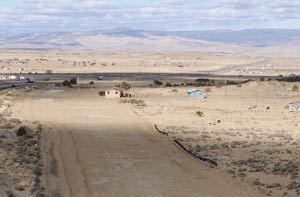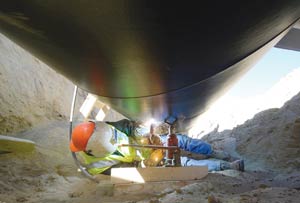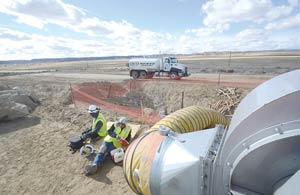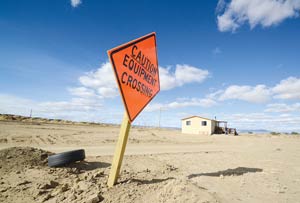Work starts on Navajo-Gallup pipeline
By Noel Lyn Smith
Navajo Times
TWIN LAKES, N.M., December 6, 2012




(Special to the Times – Donovan Quintero)
TOP: A strip of land resembling a runway is cleared away near the home of Arthur Willie Monday in Twin Lakes, N.M. The Navajo-Gallup Water Supply Project pipeline construction has begun.
SECOND FROM TOP: A welder tacks two steel pipes together with an MIG Monday on the Navajo-Gallup Water Supply Project construction site in Twin Lakes, N.M.
THIRD FROM TOP: Father and son Braden and Benjamin Sanchez, both from Bloomfield, N.M. relax during their lunch break on the Navajo-Gallup Water Supply Project construction site Monday in Twin Lakes.
FOURTH FROM TOP: A caution sign instructs drivers to watch out for Navajo-Gallup Water Supply Project construction equipment Monday near the home of Arthur Willie in Twin Lakes.
T he homemade sign indicating a residential dirt road also happens to mark the start of a four-mile section of the Navajo-Gallup Water Supply Project.
With the sound of vehicles and semi-trailers traveling on U.S. 491, construction on Reach 12A of the pipeline started in October.
The construction right of way is evident from the cleared vegetation.
On Monday, some construction crew members were busy completing a section of the blue pipeline that lies underneath a road maintained by the Bureau of Indian Affairs.
Inside the trench were a welder and a welder's helper who were preparing a black casing for tack welding. Once the casing is set, that portion of pipeline will be placed inside.
The casing will provide extra protection for the pipeline against any damage it could sustain from road activity.
At the start of the construction area a group of Navajo men spent the morning on a completed section of pipeline to clear planks and inspect the pipe for cracks.
So far 3,000 feet of pipeline has been completed.
The project is located east of the highway, running south of here and will end at a pumping station planned for Tohlakai Hill, which will provide service for the Gallup and Window Rock branches.
The Gallup branch will travel into the city, then extend to Church Rock, Iyanbito and Red Rock chapters.
Overall, it will take between 10 and 12 years to complete 280 miles of pipeline, which will eventually deliver water from the San Juan River to tribal communities and the city of Gallup.
The U.S. Bureau of Reclamation, the Navajo Nation, the city of Gallup and Indian Health Services are completing the project through a joint effort.
Reach 12A is scheduled for completion in August 2013 and construction will continue through the winter.
"They'll lay pipe as long as the weather permits," said Larry Haley, resident engineer with the Bureau of Reclamation, Four Corners Construction Office in Farmington.
Over the summer, archeologists from PaleoWest completed surface surveying at the construction site and continue to monitor the site for additional subsurface archeology discoveries.
One discovery found after groundbreaking activities was a burnt hogan, which was relocated as requested by family members.
The construction crew also works with the Navajo Nation Department of Historic Preservation to determine any relocation of objects.
This end of the pipeline was started as a way to deliver groundwater and water from existing wells to communities within two to three years as opposed to waiting eight to 10 years for the pipeline to extend south from the San Juan River, said Patrick Page, deputy construction engineer with the Bureau of Reclamation, Four Corners Construction Office.
"There are some immediate needs in this area, we figured the best way to do this, and the Navajo Nation had requested us, to start here and utilize that groundwater," Page said Monday during a tour of the construction site.
Delivering groundwater is a short-term fix but local residents will see the benefits of the project before river water is transported, he said.
Jason John, branch manager with the tribe's Water Management Department, said most homes in the area have running water but the pipeline would help with delivering water to future residences.
Another section of the pipeline project is the Cutter Lateral, which will bring water to chapters in the Eastern Navajo Agency.
A portion of the Cutter Lateral construction can be seen along U.S. 550 between Bloomfield and Bernalillo, Page said.
The Navajo-Gallup water pipeline was authorized for construction by the Omnibus Public Lands Management Act of 2009 as a major component of the Navajo Nation San Juan River Basin Water Rights Settlement in New Mexico.
It was one of 14 projects identified by President Barack Obama as in need of funding and completion.
A groundbreaking ceremony was held in June and attended by tribal and federal officials, including Navajo Nation President Ben Shelly and U.S. Secretary of the Interior Secretary Ken Salazar.
"It's about bringing water to the people, that's what this is going to do," Page said.
Twin Lakes resident Lorraine Smith can see the construction area from her home site.
"It doesn't bother me as long as they finish towards the evening," Smith said.
Although Smith has running water, she is happy about the idea of other residents receiving water for the first time.
"That's good," she said.
Twin Lakes resident Arthur Willie's house is located right next to a clearing marked for the pipeline construction.
His concern was a dirt road that was cleared to access the nearby water well. He declined to comment further about the project.
Willie's niece, Elta Yazzie, has a home site lease north of Arthur's house.
"It's a nice thing," Yazzie said about the pipeline.

